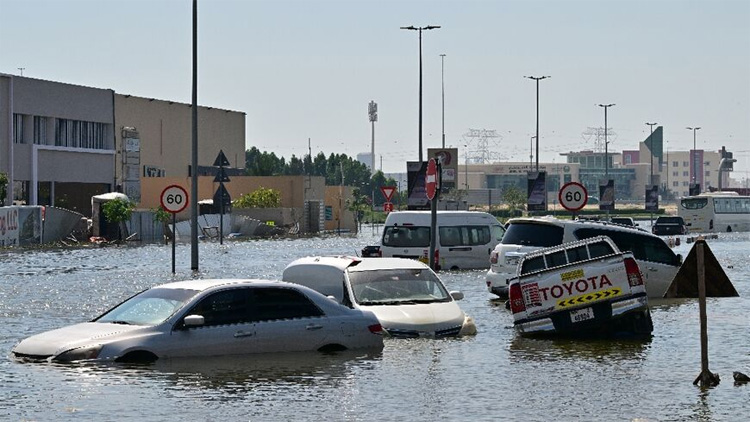Rain in El Niño years may have become 10-40% heavier due to climate crisis: Study
Heavy rainfall events in El Niño years like the one in Dubai, other parts of the United Arab Emirates (UAE), and Oman on April 14-15 may have become 10-40% heavier due to climate crisis, according to a rapid analysis of climate researchers from the World Weather Attribution Group.
El Niño, which influences patterns such as heavy rains, floods, and drought, occurs on average every two to seven years. It typically lasts nine to 12 months. El Niño is a naturally occurring climate pattern associated with ocean surface warming in the central and eastern tropical Pacific Ocean.
A disagreement about model results and observations prevented researchers from quantifying the specific contribution of climate change. The analysis did not investigate the possible influence of cloud seeding on the rainfall.
Cloud seeding is routinely carried out in the UAE for rainfall. But given the size of the storm system, massive rainfall would have happened regardless of whether cloudseeding had been carried out, the researchers said in a statement on Thursday. “Warming caused by burning fossil fuels is the most likely explanation for the increasing rainfall,” the statement said.
Climate change, caused by burning oil, coal, and gas, and deforestation, is making rainfall heavier. To quantify the effect of human-caused warming on the extreme rainfall in the Arabian Peninsula, scientists analysed weather data and climate models to compare how these types of events have changed between today’s climate, with approximately 1.2°C global warming, and the cooler pre-industrial climate, using peer-reviewed methods.
The researchers combined historical observations with climate models to investigate if climate change is driving the increase in rainfall. Most of the models analysed did not show a strong influence of global warming on heavy one-day rainfall events in the region. But again the scattered and sparse rainfall limits the researchers’ confidence in these results, the statement said.
“This is a hyper-arid area which has made this study a bit more difficult from a statistical, observational point of view than most other studies on heavy rainfall,” said Friedrike Otto, a climate scientist at Imperial College London’s Grantham Institute – Climate Change and the Environment.
Mansour Almazroui from the Center of Excellence for Climate Change Research, King Abdulaziz University in Saudi Arabia’s Jeddah, said rainfall in the region is rare. “In 2009, the Saudi Arabian region received an extreme rain of 74 mm in 2011. Around 111 mm of rainfall was recorded. In 2022, around 159 mm was recorded. This year it is 254.8 mm [in UAE’s Khatm Al Shakla in Al Ain] in less than 24 hours.”
A warmer atmosphere can hold more moisture. At 1.2°C of global warming, the atmosphere can hold about 8.4% more moisture. Changing circulation patterns driven by global warming can increase rainfall in particular regions. There are no other known explanations for the increasing rainfall in the Arabian Peninsula, the researchers said.
“Cloud seeding was reported to not have been implemented in the context of this event, and additionally even in case of implementation has no influence on the amount of atmospheric moisture available, which was the main anomalous variable preceding the precipitation event. Hence, we can conclude that cloud seeding had no significant influence in the event.”
Flash flooding is common on the Arabian Peninsula, particularly in river valleys but also in cities. In Oman and the UAE, 80% and 85% of people live in flood-prone and low-lying areas.
Heavy rainfall was forecast but floodwaters led to deaths and damage to homes, shops, offices, and cars. Most deaths occurred when people were in cars. This suggests warnings may not have reached some people or did not specifically outline what impacts could be expected in particular regions, the researchers said.
Mariam Zachariah, a researcher at the Grantham Institute – Climate Change and the Environment, said extreme rainfall events have become at least 10% heavier in the UAE and Oman. “This finding is unsurprising and agrees with the basic physics that a warmer atmosphere can hold more moisture. Model uncertainties meant we could not complete the last step of the analysis to precisely quantify how much of the increasing rainfall is due to climate change. However, multiple lines of evidence point to climate change as the most likely explanation for the increasing rainfall.”
Otto said both El Niño and human-caused climate change appear to be influencing heavy rainfall in the UAE and Oman. “We cannot stop El Niño. We can stop climate change. The solution is to stop burning fossil fuels, to stop deforestation. At COP28 [2023 UN Climate Change Conference] in Dubai, the world agreed to ‘transition away’ from fossil fuels.”
Otto said nearly half a year later, countries are still opening new oil and gas fields. “If the world keeps burning fossil fuels, rainfall in many regions of the world will get heavier and heavier, resulting in deadlier and more destructive floods,” said Otto.
Most previous heavy rainfall events in the area occurred during El Niño years, according to the analysis. “Across both countries, a high degree of surfaces with limited permeability and absorptive capacity from urban developments, inadequate drainage, and the hyper-arid soils exacerbate the risk and severity of flash floods.”
The study said UAE and Oman adopt proactive disaster risk management strategies, with functional systems for early warning, early action, and emergency response to floods, along with long-term adaptation planning. “However, reducing the high exposure to flood risk, more proactive urban planning, and integration of impact-based forecasting in EWS [Early Warning Systems] are necessary to reduce impacts associated with similar events in the future,” the analysis said.

